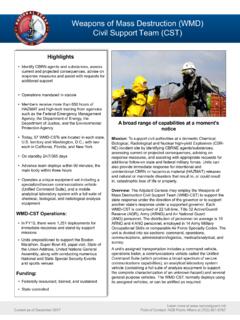Transcription of Conventional Prompt Global Strike and Long-Range …
1 Conventional Prompt Global Strike and Long-Range Ballistic Missiles: Background and Issues Updated July 16, 2021 Congressional Research Service R41464 Conventional Prompt Global Strike and Long-Range Ballistic Missiles Congressional Research Service Summary Members of Congress and Pentagon officials have placed a growing emphasis on programs to develop hypersonic weapons those that can travel at speeds greater than Mach 5 and maneuver to improve accuracy or evade defenses as they approach their targets. Initially, the United States sought to develop systems with intermediate or long range, so that they could attack targets around the world in under an hour. These types of Prompt Strike weapons might bolster efforts to deter and defeat adversaries by allowing the United States to attack high-value targets or fleeting targets at the start of or during a conflict. Congress has generally supported this mission, but restricted funding for several years in the 2000s.
2 Recently, efforts to develop a Long-Range Prompt Strike capability, along with other efforts to develop extremely fast hypersonic weapons , have garnered increased support. Prompt Strike weapons would not substitute for nuclear weapons , but would supplement Conventional capabilities. Officials have argued that the Long-Range systems would provide a niche capability, with a small number of weapons directed against select, critical targets. Some analysts, however, have raised concerns about the possibility that adversaries might misinterpret the launch of a missile with Conventional warheads and conclude that the missiles carry nuclear weapons . The Department of Defense (DOD) is considering a number of systems that might provide the United States with Long-Range Strike capabilities. The Air Force and Navy have both pursued programs that would lead to the deployment of Conventional warheads on their Long-Range ballistic missiles. During the 2000s, the Air Force and the Defense Advanced Research Projects Agency (DARPA) sought to develop a hypersonic glide delivery vehicle that could deploy on a modified Peacekeeper land-based ballistic missile, but test failures led to the suspension of this program; research continues into a vehicle that might be deployed on air-delivered or shorter-range systems.
3 In the mid-2000s, the Navy sought to deploy Conventional warheads on a small number of Trident II submarine-launched ballistic missiles, but Congress rejected the requested funding for this program. Since then, the Pentagon has continued to develop a hypersonic glide vehicle, now known as the Common Hypersonic Glide Body, which could be deployed on Long-Range missiles. This vehicle is likely to be deployed on intermediate-range missiles on Navy submarines, for what is now known as the Prompt Strike Mission. Congress may review other weapons options for the deployment of hypersonic weapons , including bombers, cruise missiles, and possibly scramjets or other advanced technologies. The Pentagon s FY2022 budget request continues to show significant increases in funding for the Navy s Conventional Prompt Strike (CPS) program. The Navy received $512 million for this program in FY2020 and requested $ billion for FY2021; Congress appropriated $ million for FY2021.
4 The Navy has requested $ billion for FY2022. This shows the growing priority placed on the program in the Pentagon and the growing interest in Congress in moving the program forward toward deployment. When Congress reviews the budget requests for Prompt Strike and other hypersonic weapons programs, it may question DOD s rationale for the mission, reviewing whether the United States might have to attack targets promptly at the start of or during a conflict, when it could not rely on forward-based land or naval forces. It might also review whether this capability would reduce reliance on nuclear weapons or whether, as some critics have asserted, it might upset stability and possibly increase the risk of a nuclear response to a attack. At the same time, Members of Congress and officials in the Pentagon have both noted that Russia and China are pursuing hypersonic weapons , leading many to question whether the United States needs to accelerate its efforts in response, or whether an acceleration of efforts might contribute to an arms race and crisis instability.
5 Conventional Prompt Global Strike and Long-Range Ballistic Missiles Congressional Research Service Contents Introduction .. 1 Policy Focus .. 1 Mission and Programs .. 2 3 The Prompt Global Strike Mission (PGS) .. 3 Rationale for the PGS Mission .. 3 PGS and the Strategic Command .. 6 Potential Targets for the PGS 6 Conventional Ballistic Missiles and the PGS 7 Plans and Programs .. 10 Air Force 10 The FALCON Study .. 10 Reentry Vehicle Research and Warhead 12 Missile Options .. 13 The Conventional Strike Missile .. 13 Hypersonic Test Vehicle (HTV-2) .. 15 ArcLight .. 16 Army Advanced Hypersonic 17 Navy Programs .. 18 Reentry Vehicle Research .. 18 Conventional Trident 20 Submarine-Launched Conventional Prompt 21 Legislative 23 FY2003 and FY2004 .. 23 FY2005 .. 24 FY2006 and FY2007 .. 24 FY2008 .. 25 FY2009 .. 27 FY2010 .. 28 FY2011 .. 28 FY2012 .. 28 FY2013 .. 29 FY2014 .. 30 FY2015 .. 31 FY2016 .. 31 FY2017 .. 32 FY2018.
6 32 FY2019 .. 33 FY2020 .. 34 FY2021 .. 34 FY2022 .. 35 Issues for Congress .. 35 Assessing the Rationale for 35 The Need for Prompt Response .. 35 Evolving Rationale .. 36 The Potential for Misunderstanding a CPGS Missile Launch .. 38 Conventional Prompt Global Strike and Long-Range Ballistic Missiles Congressional Research Service Mitigating the 38 Remaining 39 Reviewing the Alternatives .. 40 Land-Based Ballistic Missiles .. 40 Submarine-Launched Ballistic Missiles .. 41 Long-Range Bombers .. 42 Tomahawk Cruise Missiles .. 43 Hypersonic Cruise 43 Scramjet Technologies .. 43 Arms Control 44 Potential Threats from Russia and China .. 46 Weighing the Benefits and Risks .. 49 Contacts Author Information .. 50 50 Conventional Prompt Global Strike and Long-Range Ballistic Missiles Congressional Research Service 1 Introduction Members of Congress and Pentagon officials have placed a growing emphasis on programs to develop hypersonic weapons as a part of an effort to acquire the capability for the United States to launch Prompt attacks against targets around the world.
7 Hypersonic weapons , like all Long-Range ballistic missiles, can travel faster than Mach 5, or about 1 mile to 5 miles per The interest in these weapons is driven by both the perceived mission need for Conventional Prompt Strike systems and concerns about falling behind Russia and China in the development of these The United States is pursuing two key technologies for this purpose: boost-glide systems that place a hypersonic glide vehicle (HGV) atop a ballistic missile booster or shorter-range rocket systems, and hypersonic cruise missiles that would use scramjet Policy Focus This report focuses, primarily, on the Pentagon s ongoing program to develop ballistic missile-based Conventional Prompt Strike systems. This effort has been underway for nearly 20 years. The George W. Bush Administration demonstrated an interest in the use of Conventional weapons for precision, Long-Range Strike missions in the 2001 nuclear Posture Review (NPR).
8 This study called for the integration of precision Conventional weapons with strategic nuclear forces in a new category of offensive Strike Several other Pentagon studies published during the Bush Administration also called on the United States to develop the capability to attack targets around the world, in under an hour, with Conventional warheads. The Obama Administration, in the 2010 NPR, also emphasized the role that Long-Range , non- nuclear systems could play in supporting regional deterrence and reassurance goals. The 2010 NPR indicated that Conventional power projection capabilities were part of effective regional security architectures, 5 arguing that these capabilities could help the United States assure and defend its allies, while reducing the role of nuclear weapons in security strategy. The Trump Administration s nuclear Posture Review did not address the role of advanced Conventional weapons in nuclear posture, but the Administration has shown continuing support for the development of Long-Range precision Conventional weapons , with significant increases in funding in its budget requests since FY2019.
9 It also supported a joint Air Force/Navy/Army effort to develop and deploy hypersonic capabilities by the early 1 Jason L. Sherman, The Hypersonic Arms Race Heats Up, The Daily Beast, December 3, 2017, ht t hedailybeast .com/t he-hypersonic-arms-race-heat s-up. See, also, Paul McCleary, China Loves DoD Acquisit ion Cult ure, Says R&D Chief Griffin, Breaking Defense, March 6, 2018, ht t ion-cult ure-says-r/. 2 HASC Seapower Chair Wittman Presses For Hypersonic Focus, Breaking Defense, February 22, 2018, ht t t man-presses-for-hypersonic-focus/. 3 For a summary of current hypersonic weapons programs, see CRS Report R45811, Hypersonic weapons : Background and Issues for Congress, by Kelley M. Sayler. 4 Congress, Senat e Commit t ee on Armed Services, Hearing on t he nuclear P ost ure Review, St at ement of t he Honorable Douglas J. Feit h, Under Secret ary of Defense for P olicy, February 14, 2002, p.
10 4. 5 Depart ment of Defense, nuclear Posture Review, Washingt on, DC, April 6, 2010, p. 34, ht t ort als/1/features/defenseReviews/NP R/2010_Nuclear_P ost ure_Review_Report .pdf. 6 Steve Trimble and Guy Norris, Sandia s Swerve Could Lead To First-gen Hypersonic Production Line, Aviation Week, Oct ober 11, 2018, ht t ion-line. Conventional Prompt Global Strike and Long-Range Ballistic Missiles Congressional Research Service 2 Moreover, Michael Griffin, the former Under Secretary of Defense for Research and Engineering, spoke often about the challenges presented by Russian and Chinese hypersonic weapons programs and about the need for the United States to accelerate its efforts. In testimony before Congress, he noted that the United States does not have systems which can hold them at risk in a corresponding manner, and we don t have defenses against those systems. He said, It is among my very highest priorities to erase that disadvantage, creating our own systems to hold them at risk and to provide defense.












